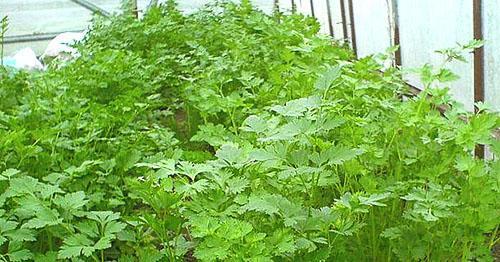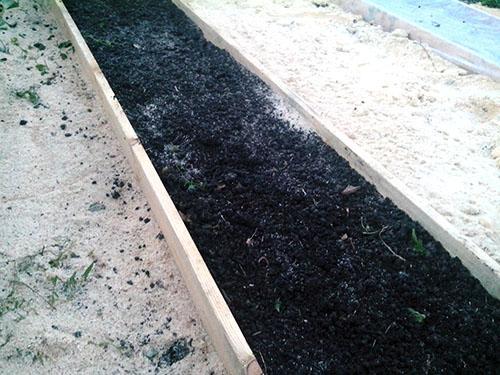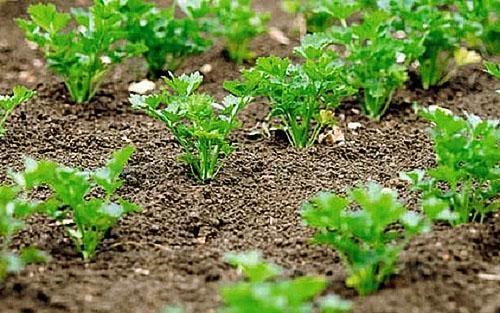Root parsley from organic farming
 Wild varieties of parsley are still found in the eastern Mediterranean region, which makes this area a true homeland of the plant. The first mentions of parsley have come down to us from the papyri of Ancient Egypt. The Egyptians seriously believed that parsley grows from drops of blood shed by the son of the god Osiris. Wreaths made from plant leaves were worn at various funeral events. The ancient Greeks also considered parsley as a symbol of loss. Naturally, such a mourning plant was not eaten.
Wild varieties of parsley are still found in the eastern Mediterranean region, which makes this area a true homeland of the plant. The first mentions of parsley have come down to us from the papyri of Ancient Egypt. The Egyptians seriously believed that parsley grows from drops of blood shed by the son of the god Osiris. Wreaths made from plant leaves were worn at various funeral events. The ancient Greeks also considered parsley as a symbol of loss. Naturally, such a mourning plant was not eaten.
Only in the ninth century in Europe, parsley began to be used as a vegetable. Many historians are convinced that a compromise has arisen, they say, if you cannot eat tops, we will use the roots. So it was or not, but from that moment on, the root parsley rightfully took its place on the European table.
Sowing root parsley in the garden

At first, it should be borne in mind that root parsley is a root crop, and all root crops require loose and, at the same time, fertile soil for their development. A good result can be achieved by planting a root crop in crop rotation after a crop grown in a garden richly seasoned with organic matter, for example, after pumpkin crops.
Root crops cannot be grown on fresh organic matter, they are distorted from this, stratified, lose their presentation and taste !!!
Secondly, parsley seeds are coated with inhibitors, substances that prevent premature seed germination. To solve the problem of slow seed germination, the stratification method is used. Its essence lies in alternating hardening at different temperatures, as if imitating natural conditions. A month before the intended sowing, in the middle lane around the first of April, we place the soaked seeds of root parsley in the refrigerator on the upper shelf. We keep it here for a week, then for a couple of days in the freezer, then again in the refrigerator, and so on until sowing. Residents of private houses, or owners of open balconies, can simply bury containers with moistened seeds in the snow.
Thirdly, it is important not to miss the time when sowing parsley outdoors. Root parsley, like carrots, parsnips and other umbellates, is sown in the garden with the very first crops as soon as the soil allows. This is necessary so that the seed, once in the soil, finds all the snow moisture. For better moisture retention, in addition, after sowing the seeds, the ridges are covered with a white non-woven material. In the narrow bed-boxes we use, it is very easy to do this by pinning the “non-woven” to the box with a stapler.
Fourth, it is necessary to observe the correct location of the landings. When orienting narrow, forty-five centimeters, ridges from north to south, we make two rows in width with a distance of 20-25 centimeters between them. In a row, the spacing should be at least five centimeters. If you sow more often, you will have to thin out the plants to avoid chopping the root parsley.
 If you follow these recommendations, the seeds will hatch already on the seventh to tenth day.After the emergence of friendly shoots, it is necessary to remove the non-woven material and mulch the bed with chopped plant residues. Grass from under the trimmer works well for this purpose. If there is still little grass, small sawdust can be used, they will not only retain moisture well, but also will not allow weeds to grow.
If you follow these recommendations, the seeds will hatch already on the seventh to tenth day.After the emergence of friendly shoots, it is necessary to remove the non-woven material and mulch the bed with chopped plant residues. Grass from under the trimmer works well for this purpose. If there is still little grass, small sawdust can be used, they will not only retain moisture well, but also will not allow weeds to grow.
We feed the root parsley
 During the growing season, the question arises: how and when to feed the root parsley? The main question here is when? Root parsley, like carrots, should be fed in a week, maximum two seedlings. Top dressing during the formation of root crops will lead to their ugliness and loss of quality. The roots of the plant will cease to stretch deeper and will try to find "food" on the surface of the garden bed. But at the beginning of the growing season, you can feed it once with "green fertilizer".
During the growing season, the question arises: how and when to feed the root parsley? The main question here is when? Root parsley, like carrots, should be fed in a week, maximum two seedlings. Top dressing during the formation of root crops will lead to their ugliness and loss of quality. The roots of the plant will cease to stretch deeper and will try to find "food" on the surface of the garden bed. But at the beginning of the growing season, you can feed it once with "green fertilizer".
Green fertilizer - infusion of finely chopped weeds. Various herbs are put into plastic or glass dishes, we mainly have nettles, and filled with water. After a week of fermentation, water the plants with a solution of this "byaki" in water in a ratio of one to ten !!!
Full harvesting of parsley root can be carried out from late September to mid-October, depending on the weather.
Sowing parsley before winter

Root parsley can be sown before winter. In this way we provide ourselves with an early friendly harvest of root crops and free up the hot spring time. Many ask the question: when to sow parsley before winter? Sowing must be done at a stable negative temperature. In the fall, we make grooves in the beds and prepare soil or sand for backfill. In winter, we put seeds in the prepared grooves and cover them with a loose substrate. We cover it with snow on top.
 Root parsley is convenient to use in winter for forcing vitamin greens. To do this, we plant the roots in high containers, leaving about two centimeters above the surface. Water and place on the windowsill. Soon, our pot will turn green and provide the family with a delicious seasoning.
Root parsley is convenient to use in winter for forcing vitamin greens. To do this, we plant the roots in high containers, leaving about two centimeters above the surface. Water and place on the windowsill. Soon, our pot will turn green and provide the family with a delicious seasoning.
Briefly about varieties
Root parsley varieties:
 Sugar - conical gray-white root vegetable, very tasty.
Sugar - conical gray-white root vegetable, very tasty. Yielding - root vegetable up to 100 grams with good taste.
Yielding - root vegetable up to 100 grams with good taste. Bordovician - a cylindrical root vegetable reaching a weight of 170 grams.
Bordovician - a cylindrical root vegetable reaching a weight of 170 grams. Berlin - late ripening variety, root crop up to 20 cm long and up to 4 cm in diameter.
Berlin - late ripening variety, root crop up to 20 cm long and up to 4 cm in diameter.
It remains to choose the variety of root parsley you like, prepare the seeds and plant them in the garden. When seedlings appear, start caring for young plants. the result of your worries will be a good harvest of healthy greens.
The article is of practical interest for the care of parsley root. Seed stratification is described in detail. Usually untreated seeds germinate for a very long time. And the correct selection of root varieties is very important. Not knowing this, I was constantly buying Berlin parsley to get roots. Several mistakes at once. Seeds were not stratified, seedlings were delayed. During growth, the foliage was cut off, and it is needed for the development of the root crop. Digging early. The variety is late, the roots turned out to be a little thicker than a pencil, and I refused to grow root crops. The article pointed out my mistakes. I'll try to grow the roots again next season.